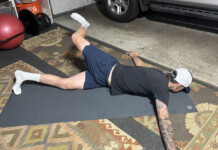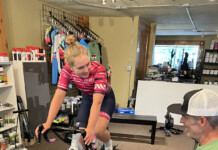Spring is in the air, the sun is warming your back, and you’ve got the hots for a new bike. It won’t have the smell of a new car, but it will have the feel of speed, joy and freedom. That’s assuming it is adjusted to fit you, and fitting starts with sizing. Which is why size matters.
A bike of the correct size offers a “fit window” to allow for adjustments to the saddle and handlebar position to suit your body and riding needs. If the bike is too big or too small for you, then it’s going to be a stretch (or a shrink) to get it close, and close will not be good enough for all day riding comfort.
Frame Size is a one dimensional measure of the height of the bike, as an actual or theoretical seat tube length. It may be expressed in inches or centimeters, or as a small, medium, large, etc. There is not a consistent agreed way to express a bike size, and so the same frame label size between different brands can vary significantly.
While size matters, you should also know that Shape does too. Two bikes labeled with the same frame size may be a very different shape, and therefore feel quite different. Frame Size does not take into account the length of the bike or the height of the front end, both influencing where the handlebars can be. These are important because they affect your reach and drop from the seat to the handlebars which determines your upper body position, which influences your back, neck and hand comfort. Seat tube angle is also an aspect of shape that influences where your center of mass and balance can be located.
Shape is two dimensional, and is defined in the frame geometry charts for each model, which show lengths and angles. Shape can be expressed descriptively. For example as race, competition, sports, or endurance for road bikes and as XC race, trail, all mountain or freeride for mountain bikes.
Shape can also be described as frame “stack and reach” co-ordinates, which defines where the head tube is in relation to the bottom bracket. These are useful numbers for comparative purposes.
Shopping for Size
When going into a store to buy a bike, you now know it is important to get the right size and shape. How is this determined? You can measure the geometry of an existing bike you ride that feels good for you, and use those specs. But if you don’t have an existing bike, or if it is not a good template, then it’s in the interest of the bike shop to help you out. There are 4 main sizing methods:
The eyeball. This is when the sales person runs their eye up and down you, and pronounces a number with confidence. It’s good for their ego, but not necessarily a quantifiable, evidence based approach. Move on…
Stand over clearance. This is useful, as no one wants to knack themselves straddling a bike, but it only takes into account one aspect of sizing, and ignores the rest. Move on…
Body measurements. Hard data like inseam length, height, torso length or sternal notch height, arm length. Now we are getting some evidence of skeletal proportions which are very useful for accurately recommending a bike size and shape, in conjunction with information about riding style and intentions, and physical factors like strength, flexibility and injury history. Be mindful that inseam length on its own is only a predictor of bike size and not bike shape. Two people with the same inseam length but different upper body portions may well be better off on different bikes. There are a number of body measurement systems available to bike stores, including the Fit Kit System which has been in use for over 30 years. This sizing is usually free if you are buying a bike at the store.
Pre-purchase fitting. This top shelf option has you riding on a size cycle (bike simulator) to determine a final fit position, and from this a recommendation of suitable bikes and components can be determined. This will typically have a cost because of the time and technology involved. The Guru Fit System is one such option, with integrated frame finder software, but there are a range of low tech to high tech size cycles around.
Buying Online or Used
If you are buying online, some websites offer a sizing guideline. These vary widely from totally useless to quite thorough. You can also go into a local bike shop that uses a sizing system, but convey your honest intentions of shopping online, and expect to pay for the sizing service. This also applies if you are buying a used bicycle, which is by far the easiest way to get a bike that will not fit. A great deal off KSL doesn’t make for a great ride if the bike is the wrong size. Measure twice, buy once. Size matters. So does shape.
John Higgins is an imported local cycling enthusiast who used to sell bikes, but now offers bike fitting services through BikeFitr and is a partner in Fit Kit Systems. He keeps a low profile, but you can find him if you want to.








